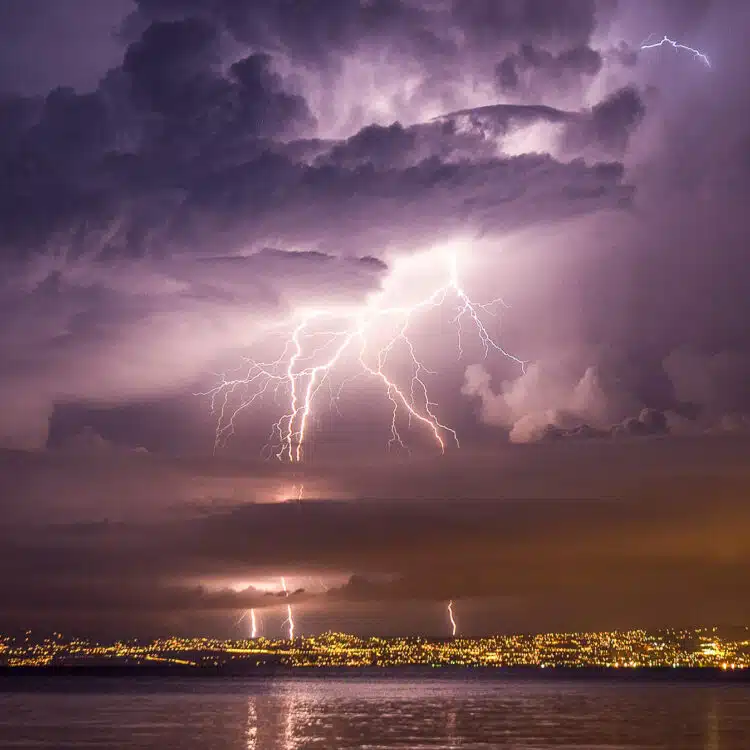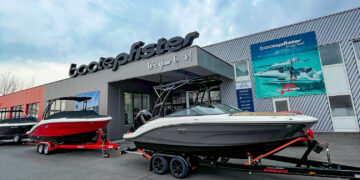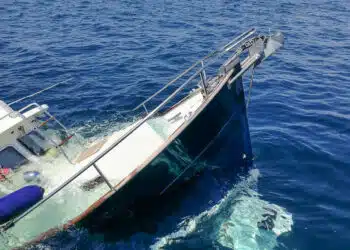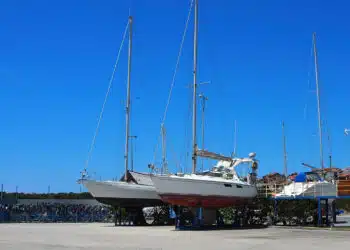Thunderstorms are often surrounded by various myths and superstitions. Whether you have to look for beech trees, and the lightning never strikes twice, and how to behave properly on land and as a sports skipper at sea (or in the harbor), if a thunderstorm is coming up, that clarifies our current article on the subject.
Sportskipper know it: despite good seamanship and previous (!) Obtaining the marine weather report, it can happen that you notice a dark and threatening wall of clouds at sea – a thunderstorm actually approaching or building up. In addition to stronger winds and higher waves, these summer thunderstorms often bring lightning, some of which can cause a great deal of damage. What to do.
First of all, a thunderstorm is a complex meteorological phenomenon associated with airborne electrical discharges (lightning and thunder). On average, about 1,600 thunderstorms occur simultaneously on Earth, covering more than 0.3 percent of the Earth’s surface. Thunderstorms are usually accompanied by powerful cloudburst-like rain or hail showers.
Before a thunderstorm front, gusty winds blow up to gale force; strong thunderstorms are called severe weather
Before a thunderstorm front, gusty winds blow with up to gale force. Less common accompanying phenomena are tornadoes and downbursts. Severe thunderstorms can also be referred to as severe weather. Summer thunderstorms occur much more frequently than winter thunderstorms, which can also be associated with heavy snow showers.
Rising warm moist air masses cause a large thundercloud (also called a cumulonimbus) to build up into the higher, colder troposphere. Such rising air currents form when a higher temperature is reached in a limited area than in the immediate vicinity (e.g., as a result of solar radiation or differential heat dissipation of the subsurface, such as water surfaces).
The lightning discharge provides a reduction of the electrical voltage built up in the thunderclouds
Lightning occurs in this process because of the high vertical wind speeds that can only occur within thunderclouds. Another condition for the formation of lightning is ice crystals within the thundercloud. Due to their size, ice crystals transport different charges and lead to further charge separation at the interfaces between updrafts and downdrafts. Finally, the lightning discharge causes the built-up electrical voltage to dissipate.
So far, so well known. Debeka Insurance dispels some myths about lightning – and how best to protect against it – in a statement it recently sent out.
Myth 1: Beech trees you must seek, oak trees you must yield
An old (German) proverb says: Before the oaks you shall give way. And the willows you shall avoid. To the spruces flee by no means, Linden you shall find, But the beeches you must seek! Debeka says: wrong! And certainly one of the most dangerous myths, because: during thunderstorms you should avoid all trees.
If the lightning strikes the trunk, the voltage can jump or branches break off. If you are on the road during a thunderstorm, it is better to go to a building or sit in the car. In open areas, find a depression, crouch down and stay low to minimize the risk of a lightning strike.
Myth 2: Lightning never strikes the same place twice
False. In fact, lightning can strike the same place more than once. Especially if the location has a high attraction for lightning or a low electrical resistance, such as tall buildings or towers.
Lightning usually strikes in locations with the path of least electrical resistance. Tall, pointed structures such as trees, buildings, towers, and mountains are typical targets for lightning because they provide the shortest path to ground. In any case, this also includes masts on yachts, especially high sailboat masts. However, this is not predictable, according to insurance professionals.
Myth 3: Swimming is life-threatening during thunderstorms
True. Get out of the water immediately! Water is an excellent conductor of electrical energy, so even if lightning doesn’t strike the water directly, it can spread electrical charges throughout the surrounding area.
This is true even more than 100 meters away. In the swimmer, these currents can cause a shock and lead to drowning.
Myth 4: During thunderstorms you are safe in the car
True. The car serves as a so-called Faraday cage during a lightning strike. Thanks to the car body, the current is diverted around the occupants in the event of a lightning strike and is discharged directly into the ground. This is true at least as long as no metal parts are touched in the car, according to the insurance experts. For motor homes and convertibles, this also applies if the top remains closed. Bicyclists and motorcyclists should better dismount during thunderstorms and move away from the vehicle.
The following applies to yachts: ships made of metal (all-metal constructions) offer the best protection inside; staying on deck during a thunderstorm should be avoided. As with land vehicles, keep windows and doors closed and avoid contact with metal objects. Boats made of plastic or wood, on the other hand, offer little to no protection unless there is an incorporated and continuous wire mesh in the cabin and hull, or the boat has its own lightning rod.
Myth 5: Pull all the plugs during thunderstorms
Yep, in buildings with lightning and surge protection, it’s actually not necessary to unplug all electrical appliances during a thunderstorm. Anyone who is unsure whether such protection is even in place should unplug particularly expensive or sensitive electronics.
Surge damage to electrical appliances is covered by household insurance. However, it is worth taking a look at the insurance conditions: Depending on the provider or insurance rate, the compensation limit for surge damage is capped on a percentage basis.
General rules of conduct when outdoors during a thunderstorm:
To minimize the likelihood of being injured by lightning on land, keep the following in mind: Seek shelter indoors or in vehicles. Vehicles with enclosed metal bodies and many buildings with lightning protection systems act as a good approximation of a Faraday cage, providing safety from high electric field strengths inside.
If no protection can be found in buildings or vehicles: to avoid being struck directly by lightning, avoid staying in open areas and on hills and ridges, avoid staying in bodies of water and swimming pools.
To keep crotch voltage low when lightning strikes nearby: Put feet together, squat, keep arms close to body and head tucked in. Do not lie flat on the ground, rubber soles and insulating materials as a standing surface are beneficial.

The so-called secondary effects of lightning can also be dangerous
To avoid being affected by secondary effects, avoid the immediate vicinity of trees, poles and towers. Lightning is especially likely to strike tall objects, especially if they are freestanding. If the footprint of the object is small, the potential difference of the ground in its immediate vicinity is particularly large and the potential step voltage is therefore particularly high.
If the object’s conductivity is limited, such as with trees, there is a risk of ejected parts being thrown around and the lightning escaping close to the ground.
What to do if you are caught in a thunderstorm at sea?
But what to do if you are just at sea with your boat? Is it dangerous? That depends entirely on the construction, says for example segelschief.com. The lightning, when it strikes, will usually strike in the masthead. The discharge path is then via shrouds and stage, and the lightning seeks the shortest and strongest path to ground. In most cases, the electronics on board then suffer or burn out due to the high inductive voltage.
And: the rapidly burning applications on the mast (e.g. radio antenna) can cause massive flying sparks, warns segelschief.com. That, in turn, could lead to burn holes on the deck, sprayhood, bimini, etc., and in the worst case, a ship fire.
Tip from sailing professionals: during a thunderstorm, never touch the railing or rigging, and any contact with conductive surfaces on the ship should be avoided at all costs. Classic charter yachts, which have a GRP hull, would also not represent a Faraday cage, the lightning discharge occurs here via the shortest path from the point of impact (typically the mast) to the water.
Shrouds and stage should have a direct conductive connection to the keel or have a solid conductive contact into the water
Shrouds and stage should therefore have a direct, conductive connection to the (conductive) keel or have a solid conductive contact into the water, advises the sailing professional. If this is the case, the lightning is diverted into the water, and there is then relatively little danger for the ship (but still for the electronics). The connection to the water is important here.
The skipper should make sure that the shrouds are at least six millimeters thick and that the connection to the water is very strong and multiple. If the mast is made of aluminum with an external metal keel, a conductive connection between the mast base and the metal keel or metal centerboard is sufficient.
In the case of steel/aluminum ships, there is a continuous, conductive connection to the water due to the design. Thus, the entire hull is a Faraday cage and optimally conducts lightning directly into the water. Nevertheless, total loss of electronics is sometimes reported.

If the ship has no lightning protection, you can improvise
If the ship does not have lightning protection, there are still some ways to be able to limit the damage on board, according to the experts at segelschief.com. For example, in the absence of a lightning rod, the anchor chain can be wrapped around the forestay (prior to the outbreak of the thunderstorm) (contact with the aluminum of the forestay must be ensured). Then the anchor should be hung at least 1.5 meters into the water.
Special clamps can also be used to attach thick copper wires to the shrouds. These copper wires should be stripped and hung at least 1.5 meters into the water.
If a lightning protection system is present, the equipotential bonding should be checked regularly
During thunderstorms (if it is unavoidable to stay on board) you should stay below deck if possible (Faraday cage). No shrouds, stage, railing or other metallic objects on board should be touched.
If a lightning protection system is in place, check regularly beforehand (and not during a thunderstorm) whether the equipotential bonding (i.e. the connection of all metal-conducting equipment on board to the lightning conductor) is in order.
Thunderstorms do not come out of the blue, a sure indication – among others – is usually a sharp drop in air pressure
Safety on board depends on anticipatory behavior: A thunderstorm comes (except in the Alps and the Alpine foothills), never “out of the blue”; those who regularly take a look at the sky can recognize an approaching thunderstorm early on by the dark and threatening-looking clouds.
“One recognizes an approaching thunderstorm by the strongly falling air pressure”, says SeaHelp managing director Wolfgang Dauser; the clouds are then mostly “dark and higher than wide”. Further characteristics of an approaching thunderstorm: one hears distant thunder and perceives under circumstances weather lights.
Rain or hail showers move over the water. Cracking sounds when receiving radio in the medium-wave and long-wave ranges can also be signs of a thunderstorm building or approaching.
If lightning has struck and crippled electronics, it may not be possible to start the engine
“If you are anchored in the bay or at an anchor buoy, or if you are sailing in the open ocean, the engine should be started before the thunderstorm, and left running for as long as the thunderstorm lasts,” Dauser recommends. Reason: once lightning has struck and paralyzed the electronics, the engine may no longer be able to be started.
In addition, the SeaHelp professional recommends: “Harbour and marina berth holders should disconnect the shore power cable from the mains and seek out closed buildings” (see above). One should leave the ship in port, if possible. All mobile electronics such as tablets, portable GPS devices, radios, etc. should be taken with you if possible, says Wolfgang Dauser. Non-mobile electronics should be disconnected, and the main switch for on-board power should be turned off.
Loose equipment on deck should be secured from the thunderstorm; anchor buoy lines and anchor chains should be fanned out a bit
Since strong squalls, heavy rain or even hail should be expected during the storm, loose equipment on deck should be secured. “The mooring lines on anchor buoys should be extended somewhat so that the pull on the weight of the buoys is flatter and thus somewhat weakened,” the SeaHelp managing director also recommends; anchors should additionally deploy chain.
Thunderstorms announce themselves fortunately mostly before – enough time, in order to seek a safe place of refuge
Thunderstorms usually form on Central European seacoasts over a long period of time. This corresponds, for example, to the British marine weather service’s language rule for storm warnings: imminent means within the next six hours, soon means within twelve hours, and later means in the time that follows. The German marine weather report issues storm warnings for the next twelve hours.
Uppermost principle remains: “If the thunderstorm has been noticed, depending on its distance and speed, the safest accessible place of refuge should be targeted”, says SeaHelp managing director Wolfgang Dauser.
24h EMERGENCY CALL EUROPE: 0043 50 43 112
In an emergency, SeaHelp’s response boats can be called using the handy SeaHelp app, or by calling the free emergency number for Europe 0043 50 43 112 (or the alternative emergency number for Europe 00385 919 112 112.
Download SeaHelp app:
* terminal or telecommunication service charges may apply.















